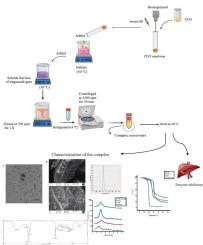明胶与黄芪胶可溶部分复凝聚包封肉桂精油乳液的表征及抗糖尿病活性
IF 8.2
1区 农林科学
Q1 CHEMISTRY, APPLIED
引用次数: 0
摘要
用明胶(GE)和黄芪胶(STG)的可溶部分按1:2、1:1和2:1的比例制备复合凝聚物,包封肉桂精油(CEO)。评估这些凝聚体的颗粒产率、包封效率和包封率。GE2:STG1/ ceo50%、GE1:STG1/ ceo25%和GE1:STG1/ ceo50%包封效率最高,后者包封率最高,为最佳配方。FTIR证实了分子间的相互作用,而显微镜显示表面粗糙,没有裂纹。热重分析表明,CEO的热稳定性得到了改善。毒性试验结果表明,包封降低了CEO的细胞毒性。模拟肠道条件下CEO释放量(42.63%)高于胃条件下(34.91%)。包封的CEO抑制α-淀粉酶和α-葡萄糖苷酶活性呈剂量依赖性。这些研究结果表明,GE-STG凝聚体是一种有效的、生物相容性好的给药系统,具有更好的稳定性、控制肠道释放和增强抗糖尿病潜力。本文章由计算机程序翻译,如有差异,请以英文原文为准。

Characterization and antidiabetic activity of cinnamon essential oil emulsion encapsulated by complex coacervation between gelatin and soluble fraction of tragacanth gum
Complex coacervates of gelatin (GE) and the soluble fraction of tragacanth gum (STG) at ratios of 1:2, 1:1, and 2:1 were developed to encapsulate cinnamon essential oil (CEO). These coacervates were assessed for particle yield, encapsulation efficiency, and encapsulation yield. GE2:STG1/CEO50 %, GE1:STG1/CEO25 %, and GE1:STG1/CEO50 % showed the highest encapsulation efficiency, with the latter also exhibiting the highest encapsulation yield, identifying it as the optimal formulation. FTIR confirmed intermolecular interactions, while microscopy showed rough surfaces without cracks. Thermogravimetric analysis revealed improved CEO thermal stability. Toxicity assay results showed that encapsulation reduced the cytotoxicity of CEO. CEO release was higher under simulated intestinal (42.63 %) than gastric (34.91 %) conditions. The encapsulated CEO inhibited α-amylase and α-glucosidase activities dose-dependently. These findings suggest that GE–STG coacervates provide an effective and biocompatible delivery system for CEO, offering improved stability, controlled intestinal release, and enhanced antidiabetic potential.
求助全文
通过发布文献求助,成功后即可免费获取论文全文。
去求助
来源期刊

Food Chemistry: X
CHEMISTRY, APPLIED-
CiteScore
4.90
自引率
6.60%
发文量
315
审稿时长
55 days
期刊介绍:
Food Chemistry: X, one of three Open Access companion journals to Food Chemistry, follows the same aims, scope, and peer-review process. It focuses on papers advancing food and biochemistry or analytical methods, prioritizing research novelty. Manuscript evaluation considers novelty, scientific rigor, field advancement, and reader interest. Excluded are studies on food molecular sciences or disease cure/prevention. Topics include food component chemistry, bioactives, processing effects, additives, contaminants, and analytical methods. The journal welcome Analytical Papers addressing food microbiology, sensory aspects, and more, emphasizing new methods with robust validation and applicability to diverse foods or regions.
 求助内容:
求助内容: 应助结果提醒方式:
应助结果提醒方式:


